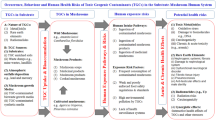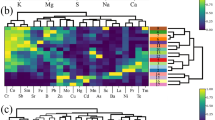Abstract
Foraging for edible and medicinal mushrooms is a cultural and social practice both globally and in the United States. Determining the toxic and nutrient element concentrations of edible and medicinal mushrooms is needed to ensure the safe consumption of this food source. Our research examined wild, foraged mushrooms in New England, USA to assess nutrient (Ca, K, Mg, P) and toxic (As, Hg, Pb, Cd) element relationships between mushrooms, substrates, and soils. We examined a gradient in nutrient and toxic elements from more rural Mountain and Hill Zones in Massachusetts, Vermont, and New Hampshire to more developed and urban Valley and Coastal Zones in Connecticut. Substrates and mineral soils were moderate to weak predictors of mushroom tissue concentrations. We found significant differences in nutrient and toxic element concentration among the five common genera: Ganoderma, Megacollybia, Pluteus, Pleurotus, and Russula. In particular, Pluteus had consistently higher toxic element concentrations while Pleurotus and Russula had the highest Bioaccumulation Factors (BAFs). We found that the urban areas of the Valley and Coastal zones of Connecticut had Cd Target Hazard Quotient (THQ) values and ΣTHQ values > 1.0, indicating potential non-carcinogenic health hazard. However, the trend was largely driven by the > 2.0 Cd THQ for Pluteus. Our results suggest that foraging in more urban areas can still yield mushrooms with safe concentrations of toxic elements and abundant nutrients. Further research of this kind needs to be conducted within this region and globally to ensure humans are consuming safe, foraged mushrooms.





Similar content being viewed by others
Data Availability
Mushroom, substrate, and soil data are available in the supplementary materials.
References
Ab Rhaman SMS, Naher L, Siddiquee S (2022) Mushroom Quality Related with Various Substrates’ Bioaccumulation and Translocation of Heavy Metals. J Fungus 8(1):42. https://doi.org/10.3390/jof8010042
Baldrian P (2008) Wood-inhabiting ligninolytic basidiomycetes in soils: Ecology and constraints for applicability in bioremediation. Fungal Ecol 1(1):4–12. https://doi.org/10.1016/j.funeco.2008.02.001
Baroni TJ (2017) Mushrooms of the Northeastern United States and Eastern Canada. Timber Press, Oregon
Berthelsen BO, Olsen RA, Steinnes E (1995) Ectomycorrhizal heavy metal accumulation as a contributing factor to heavy metal levels in organic surface soils. Sci Total Environ 170(1–2):141–149. https://doi.org/10.1016/0048-9697(95)04701-2
Breene WM (1990) Nutritional and Medicinal Value of Specialty Mushrooms. J Food Prot 53(10):883–894. https://doi.org/10.4315/0362-028X-53.10.883
Cayir A, Coşkun M, Coşkun M (2009) The Heavy Metal Content of Wild Edible Mushroom Samples Collected in Canakkale Province, Turkey. Biol Trace Elem Res 134(2):212–219. https://doi.org/10.1007/s12011-009-8464-0
Chen XH, Zhou HB, Qiu GZ (2009) Analysis of Several Heavy Metals in Wild Edible Mushrooms from Regions of China. Bull Environ Contam Toxicol 83:280–285. https://doi.org/10.1007/s00128-009-9767-8
Cincotta MM, Perdrial JN, Shavitz A et al (2019) Soil aggregates as a source of dissolved organic carbon to streams: an experimental study on the effect of solution chemistry on water extractable carbon. Front Environ Sci 172. https://doi.org/10.3389/fenvs.2019.00172
de Oliveira AP, Naozuka J, Landero-Figueroa JA (2022) The protective role of selenium against uptake and accumulation of cadmium and lead in white oyster (Pleurotus ostreatus) and pink oyster (Pleurotus djamor) mushrooms. Food Addit Contam Part A Chem Anal Control Expo Risk Assess 39(3):508–524. https://doi.org/10.1080/19440049.2022.2026494
Falandysz J, Szymczyk K, Ichihashi H, Bielawski L, Gucia M, Frankowska A, Yamasaki SI (2001) ICP/MS and ICP/AES elemental analysis (38 elements) of edible wild mushrooms growing in Poland. Food Addit Contam 18(6):503–513. https://doi.org/10.1080/02652030119625
Fu Z, Liu G, Wang L (2020) Assessment of potential human health risk of trace elements in wild edible mushroom species collected from Yunnan Province, China. Environ Sci Pollut Res 27:29218–29227. https://doi.org/10.1007/s11356-020-09242-w
García M, Alonso J, Fernández M et al (1998) Lead Content in Edible Wild Mushrooms in Northwest Spain as Indicator of Environmental Contamination. Arch Environ Contam Toxicol 34:30–335. https://doi.org/10.1007/s002449900326
Gebrelibanos M, Megersa N, Taddesse AM (2016) Levels of essential and non-essential metals in edible mushrooms cultivated in Haramaya, Ethiopia. Int J Food Contam 3(2). https://doi.org/10.1186/s40550-016-0025-7
Haro R, Benito B (2019) The role of soil fungi in K+ plant nutrition. Int J Mol Sci 20(13):3169. https://doi.org/10.3390/ijms20133169
Isildak O, Turkekul I, Elmastas M, Aboul-Enein HY (2007) Bioaccumulation of Heavy Metals in Some Wild-Grown Edible Mushrooms. Anal Lett 40(6):1099–1116. https://doi.org/10.1080/00032710701297042
Kalač P (2012) A review of chemical composition and nutritional value of wild-growing and cultivated mushrooms. J Sci Food Agric 93:209–218. https://doi.org/10.1002/jsfa.5960
Kalac̆ P, Niz̆nanská M, Bevilaqua D, Stas̆ková I (1996) Concentrations of mercury, copper, cadmium and lead in fruiting bodies of edible mushrooms in the vicinity of a mercury smelter and a copper smelter. Sci Total Environ 177(1–3). https://doi.org/10.1016/0048-9697(95)04850-2
Kokkoris V, Massas I, Polemis E, Koutrotsios G, Zervakis GI (2019) Accumulation of heavy metals by wild edible mushrooms with respect to soil substrates in the Athens metropolitan area (Greece). Sci Total Environ 685:280–296. https://doi.org/10.1016/j.scitotenv.2019.05.447
Li X, Chen G, Li X, Yao F (2023) Three Pleurotus mushroom species cultivated in a mixed Phragmites australis substrate differ in nutrient utilization capacity. J Food Compos Anal 115. https://doi.org/10.1016/j.jfca.2022.104924
Lincoff G (1981) The Audubon Society field guide to North American mushrooms. Knopf, New York
Liu B, Huang Q, Cai H, Guo X, Wang T, Gui M (2015) Study of heavy metal concentrations in wild edible mushrooms in Yunnan Province, China. Food Chem 188:294–300. https://doi.org/10.1016/j.foodchem.2015.05.010
Malinowski R, Sotek Z, Stasińska M, Malinowska K, Radke P, Malinowska A (2021) Bioaccumulation of Macronutrients in Edible Mushrooms in Various Habitat Conditions of NW Poland-Role in the Human Diet. Int J Environ Res Public Health 18(16):8881. https://doi.org/10.3390/ijerph18168881
Malone T, Swinton SM, Pudasainee A et al (2022) Economic Assessment of Morel (Morchella spp.) Foraging in Michigan, USA. Econ Bot 76:1–15. https://doi.org/10.1007/s12231-022-09548-5
McClaugherty C, Berg B (1987) Cellulose, lignin and nitrogen concentrations as rate regulating factors in late stages of forest litter decomposition. Pedobiologia 30(2):101–112. https://doi.org/10.1016/S0031-4056(23)00361-X
Naples BK, Fisk MC (2010) Belowground insights into nutrient limitation in northern hardwood forests. Biogeochemistry 97:109–121. https://doi.org/10.1007/s10533-009-9354-4
Ouzouni PK, Petridis D, Koller WD, Riganakos KA (2009) Nutritional value and metal content of wild edible mushrooms collected from West Macedonia and Epirus, Greece. Food Chem 115(4):1575–1580. https://doi.org/10.1016/j.foodchem.2009.02.014
Pająk M, Gąsiorek M, Jasik M, Halecki W, Otremba K, Pietrzykowski M (2020) Risk Assessment of Potential Food Chain Threats from Edible Wild Mushrooms Collected in Forest Ecosystems with Heavy Metal Pollution in Upper Silesia, Poland. Forests 11(12):1240. https://doi.org/10.3390/f11121240
Pecina V, Valtera M, Drápela K et. al (2022) Influence of beech and spruce on potentially toxic elements-related health risk of edible mushrooms growing on unpolluted forest soils. Sci Rep 12. https://doi.org/10.1038/s41598-022-09400-9
Podlasińska J, Proskura N, Szymańska A (2015) Content of Pb, Hg, Zn, MN, Cu and Fe in Macrofungi Collected from Wkrzanska Forest in Northwestern Poland. Pol J Environ Stud 24(2):651–656. https://doi.org/10.15244/pjoes/26959
Raut JK, Upadhyaya J, Raghavan V et al (2019) Trade and Conservation of Morel Mushrooms in Nepal. Int J Nat Ressour Ecol Manag 4(6):183–187. https://doi.org/10.11648/j.ijnrem.20190406.14
Richardson JB (2020) Urban forests near municipal solid waste incinerators do not show elevated trace metal or rare earth element concentrations across three cities in the northeast USA. Environ Sci Pollut Res 27(17):21790–21803. https://doi.org/10.1007/s11356-020-08439-3
Richardson JB, Friedland AJ (2016) Influence of coniferous and deciduous vegetation on major and trace metals in forests of northern New England, USA. Plant Soil 402:363–378. https://doi.org/10.1007/s11104-016-2805-5
Sahoo S, Gayakwad T, Shahi S (2022) Medicinal value of edible mushrooms: A review. Int J Heatlh Sci 6(S2):8760–8767. https://doi.org/10.53730/ijhs.v6nS2.7263
Sharma P, Kumar S (2021) Bioremediation of heavy metals from industrial effluents by endophytes and their metabolic activity: Recent advances. Bioresour Technol 339. https://doi.org/10.1016/j.biortech.2021.125589
Singdevsachan SK, Patra JK, Tayung K et al (2014) Evaluation of nutritional and nutraceutical potentials of three wild edible mushrooms from Similipal Biosphere Reserve, Odisha, India. J Verbr Lebensm 9:111–120. https://doi.org/10.1007/s00003-014-0861-4
Snyder EE, Buoscio BW, Falke JJ (1990) Calcium(II) Site Specificity: Effect of Size and Charge on Metal Ion Binding to an EF-Hand-like Site. Biochemistry 29(16):3937–3943. https://doi.org/10.1021/bi00468a021
Svoboda L, Havlíčková B, Kalač P (2005) Contents of cadmium, mercury and lead in edible mushrooms growing in a historical silver-mining area. Food Chem 96(4):580–585. https://doi.org/10.1016/j.foodchem.2005.03.012
Talbot JM, Bruns TD, Smith DP et al (2013) Independent roles of ectomycorrhizal and saprotrophic communities in soil organic matter decomposition. Soil Biol Biochem 57:282–291. https://doi.org/10.1016/j.soilbio.2012.10.004
Tekaya M, Mechri B, Mbarki N et al (2017) Arbuscular mycorrhizal fungus Rhizophagus irregularis influences key physiological parameters of olive trees (Olea europaea L.) and mineral nutrient profile. Photosynthetica 55:308–316. https://doi.org/10.1007/s11099-016-0243-5
Turkekul I, Elmastas M, Tüzen M (2004) Determination of iron, copper, manganese, zinc, lead, and cadmium in mushroom samples from Tokat, Turkey. Food Chem 84(3):389–392. https://doi.org/10.1016/S0308-8146(03)00245-0
Tuzen M, Sesli E, Soylak M (2007) Trace element levels of mushroom species from East Black Sea region of Turkey. Food Control 18(7):806–810. https://doi.org/10.1016/j.foodcont.2006.04.003
Vitousek PM, Gosz JR, Grier CC et al (1979) Nitrate Losses from Disturbed Ecosystems. Science 204(4392):469–474. https://doi.org/10.1126/science.204.4392.469
Woldegiorgis AZ, Abate D, Haki GD, Ziegler GR (2015) Major, Minor and Toxic Minerals and Anti-Nutrients Composition in Edible Mushrooms Collected from Ethiopia. J Food Process Technol 6(3). https://doi.org/10.4172/2157-7110.1000430
Wong C, Roberts SM, Saab IN (2022) Review of regulatory reference values and background levels for heavy metals in the human diet. Regul Toxicol Pharmacol 130:105122. https://doi.org/10.1016/j.yrtph.2022.105122
Yamaç M, Yıldız D, Sarıkürkcü C, Çelikkollu M, Solak MH (2007) Heavy metals in some edible mushrooms from the Central Anatolia, Turkey. Food Chem 103(2):263–267. https://doi.org/10.1016/j.foodchem.2006.07.041
Acknowledgements
We would like to thank Rhea Negron for assistance during field work sampling. We would additionally like to give a special thanks to William Lee, Ph.D. for funding the summer portion of this project through the William Lee Science Impact Program.
Funding
This work funded by grants to Justin Richardson and Marissa Hanley from the College of Natural Sciences at the University of Massachusetts Amherst, partially through the William Lee Science Impact Program.
Author information
Authors and Affiliations
Contributions
Marissa L. Hanley led conceptualization, field and laboratory methodology, manuscript writing, data visualization, statistical analyses, and manuscript editing for the study. Eric Vukicevich contributed to sample collection, mushroom identification, field methodology, conceptualization of experimental design, manuscript writing, and manuscript editing. Alexandrea Rice contributed to sample collection, mushroom identification, field methodology, experimental design, manuscript writing, and manuscript editing. Justin B. Richardson contributed through project conceptualization, field and laboratory methodology, project administration, manuscript writing, data visualization, statistical analyses, manuscript writing, and manuscript editing.
Corresponding author
Ethics declarations
Ethical approval
Not Applicable.
Consent to participate and publish
Not Applicable.
Competing interests
The authors declare no competing interests.
Additional information
Responsible Editor: Philippe Garrigues
Publisher's Note
Springer Nature remains neutral with regard to jurisdictional claims in published maps and institutional affiliations.
Supplementary Information
Below is the link to the electronic supplementary material.
Rights and permissions
Springer Nature or its licensor (e.g. a society or other partner) holds exclusive rights to this article under a publishing agreement with the author(s) or other rightsholder(s); author self-archiving of the accepted manuscript version of this article is solely governed by the terms of such publishing agreement and applicable law.
About this article
Cite this article
Hanley, M.L., Vukicevich, E., Rice, A.M. et al. Uptake of toxic and nutrient elements by foraged edible and medicinal mushrooms (sporocarps) throughout Connecticut River Valley, New England, USA. Environ Sci Pollut Res 31, 5526–5539 (2024). https://doi.org/10.1007/s11356-023-31290-1
Received:
Accepted:
Published:
Issue Date:
DOI: https://doi.org/10.1007/s11356-023-31290-1




